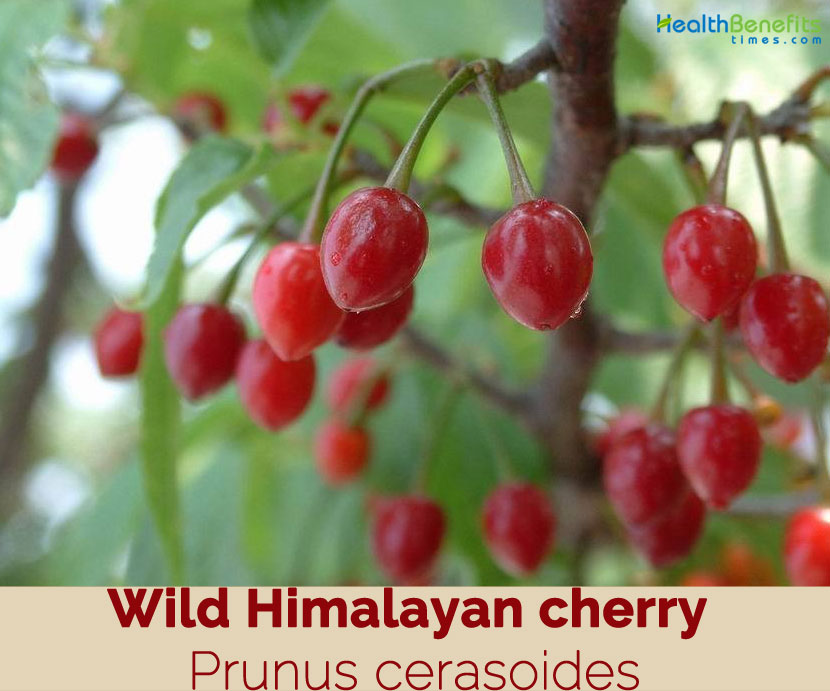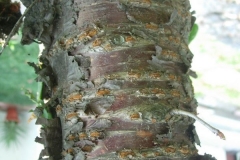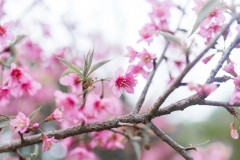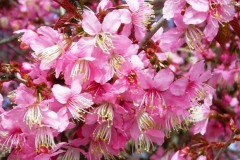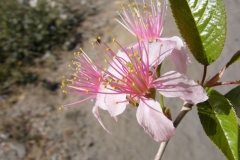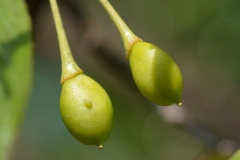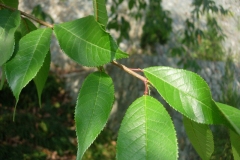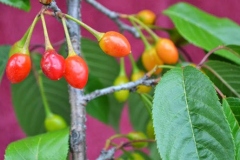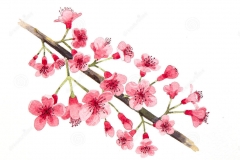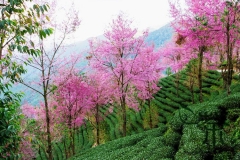| Wild Himalayan cherry Quick Facts |
| Name: |
Wild Himalayan cherry |
| Scientific Name: |
Prunus cerasoides |
| Origin |
East Asia, South Asia and Southeast Asia |
| Colors |
Initially yellow turns red as it ripens |
| Shapes |
Ovoid fruit 1.2-1.5 cm long, about 15 mm in diameter, glabrous, shining, supported by base of calyx tube |
| Taste |
Astringent |
| Health benefits |
Beneficial for backaches, hemicranias, fractured bone, painful outgrowth below lounge, burn, indigestion, leucoderma, leprosy, erysipelas, burnings, vomiting, asthma, hiccough thirst, diarrhea and cardiac debility |
Prunus cerasoides, commonly known as wild Himalayan cherry and sour cherry, is a deciduous cherry tree of Prunus genus and Rosaceae (Rose family). The plant is native to East Asia, South Asia and Southeast Asia. Its range extends in the Himalayas from Himachal Pradesh in north-central India, to Southwest China, Burma and Thailand. It grows in temperate forest from 1,200–2,400 meters (3,900–7,900 ft.) in elevation. Some of the popular common names of the plant are Padam, Wild Himalayan Cherry, Dwarf Cherry and bird cherry.
In India the plant is restricted to sub-montane and montane Himalaya ranging from 1500-2400 m asl. In Garhwal Hills it is spread plentifully in temperate zones of Pauri, Tehri, Chamoli and Uttarkashi districts. Locally it is known as ‘Panyyan’. It is adored in all auspicious occasions by the inhabitants. People never cut the whole tree and use only its twigs in rituals as the wood are forbidden to be used as fuel. Thus it is common to observe quite old trees of Prunus cerasoides in the area. But the potential of the plant as rich source of pollen and nectar for honey bees is not tapped adequately.
Plant Description
Wild Himalayan cherry is a medium sized deciduous tree that grows up to 30 meters (98 ft.) in height. The plant prefers light sandy, moisture-retentive, medium loamy and heavy clay soils and needs well drained condition. Bark is brownish-grey, smooth and peels off in thin shining horizontal stripes exposing a shining copper colored surface. Leaves are conduplicate in bud, elliptic or ovate lanceolate, 3.5-8.5 cm long, apex acuminate, both surfaces are glabrous, dark glossy, shining above, finely simple or double serrate, with gland tip teeth. Petioles are 1.2-2 cm long, stipules are long and subulate.
Flowers and Fruits
Flowers are pinkish white or crimson 1.2-2.5 cm in diameter, appearing before the leaves in umbellate fascicles and are the rich sources of nectar and pollen for bees. Pedicels are 0.5-2cm long. Calyx is bell shaped, 5-lobed, ovate-acute; petals 5, obovate. Flowering normally takes place from October and lasts up to mid-December and is pollinated by Insect. Fertile flowers are followed by ovoid fruit 1.2-1.5 cm long, about 15 mm in diameter, glabrous, shining, supported by base of calyx tube and contain one large seed. Fruits are initially yellow which turns to red as it ripens.
Traditional uses and benefits of using Wild Himalayan cherry
- In small quantities, hydrogen cyanide has been shown to stimulate respiration and improve digestion, it is also claimed to be of benefit in the treatment of cancer.
- Juice of the bark is applied externally to treat backaches.
- Bark paste is applied over the forehead for hemicranias and is also used as plaster for fractured bone, painful outgrowth below lounge, burn, indigestion, fever, foot and mouth diseases and dislocations. Paste of bark also used in wound healing.
- Amulet of bark tied in arm or waste of child for their wellbeing.
- Bark is used in the preparation of hair oil for massage.
- Paste of the bark is beneficial in neuralgia and is given to check over sweating in the body.
- Stems and branches are used for the treatment of gravel, kidney stones, asthma, thirst, leucoderma, leprosy and vomiting.
- Stem is reported to be useful in vomiting, thirst, asthma, leprosy and leucoderma.
- Decoction of stem bark is concentrated at low temperature and applied to cure joint pains.
- Heartwood is moderately hard, strong, aromatic, astringent, bitter, acrid, refrigerant, antipyretic and tonic.
- It is useful in vitiated conditions of pitta, burning sensations, sprains, wounds, ulcers, leprosy, stomach troubles, seminal weakness and skin discolorations.
- It is beneficial in hallucinations, leucoderma, erysipelas, burnings, vomiting, asthma, hiccough thirst, diarrhea and cardiac debility.
- Fruit is astringent, and digestive.
- Seed kernel is used in the treatment of stone and gravel in the kidney.
- Seed are chewed in case of kidney stone and also useful in bleeding disorders, burning sensation and skin diseases.
- Smaller branches are crushed and soaked in water and taken internally to stop abortion.
- It is also beneficial in scorpion stings.
- Powered shell charcoal is used as tooth powder.
- Plant is used in along with other fragrant drugs as a medicated smoking wick.
- Honey is slightly bitter in taste but medicinal in properties and used to treat eye ailments.
- The native of the Punjab considers the fruits to be useful as an ascaricide.
- Bark is used in dropsy in Indochina.
- Flowers are considered diuretic and laxative.
- Seeds are used as anti-helmintic.
- Peach kernels are given for cough, blood disease and rheumatism in Malaya and China.
- In Ayurveda, the plant is called as Padmaka and is recommended for the treatment of skin diseases and said to enhance the complexion.
- Leaf extract of the plant is used in prostate and urinary disorder.
- Powder of the plant is applied in the form of paste in the treatment of skin diseases to improve the complexion of skin and to treat herpes.
- Kernel is used as a remedy for stone and gravel in urinary bladder.
- Leaves, twigs and bark contain a cyanogenetic substance.
- Its stem is antipyretic, refrigerant and useful in treating vomiting, leprosy and leucoderma.
- The bark paste is applied on contusions
Culinary uses
- Fruit can be consumed raw or cooked.
- Acid and astringent, they are only occasionally eaten raw but are more often cooked.
- Gum obtained from the trunk, can be used as a substitute for gum tragacanth.
- Seed can be consumed raw or cooked.
- Ripe fruits are edible, however occasionally eaten raw due to acidic and astringent taste, but are more often cooked and used to make sauces and cherry brandy.
Other Facts
- Green dye can be obtained from the leaves.
- Dark grey to green dye can be obtained from the fruit.
- Seeds are used as beads in necklaces and rosaries.
- Wood, branches and root suckers make excellent walking sticks and umbrella crooks.
- It is used in rituals by the local inhabitants, especially in Gharwal Himalaya.
- People never cut the whole tree and use only its twigs in rituals as the wood are forbidden to be used as fuel.
- Wood of the tree is moderately hard, strong, durable and aromatic, so used by locals in several rituals.
- Heartwood is occasionally used for buildings and making ornamental furniture.
- Leaves are used as fodder and young twigs are used as toothbrush.
- The bark is a source of tannins.
- Tree is mainly used as rootstock for cultivation of cherries.
- The plant is regarded as sacred and is conserved for religious purposes.
- Flowers are useful source of bee-forage. Its pinkish-white flowers are the rich source of nectar and pollen for bees.
- Tree is used as a pioneer species in reforestation.
- Seed kernels, leaves, twigs and bark are used medicinally.
Precautions
- In larger concentrations, however, cyanide can cause gasping, weakness, excitement, pupil dilation, spasms, convulsions, coma and respiratory failure leading to death.
References:
https://pfaf.org/user/Plant.aspx?LatinName=Prunus+cerasoides
https://en.wikipedia.org/wiki/Prunus_cerasoides
http://www.theplantlist.org/tpl1.1/record/rjp-8103
https://indiabiodiversity.org/species/show/264816
https://sites.google.com/site/efloraofindia/species/m—z/r/rosaceae/prunus/prunus-cerasoides
http://www.flowersofindia.net/catalog/slides/Wild%20Himalayan%20Cherry.html
http://tn-grin.nat.tn/gringlobal/taxonomydetail.aspx?id=29865
http://tropical.theferns.info/viewtropical.php?id=Prunus+cerasoides
https://gd.eppo.int/taxon/PRNCS
https://npgsweb.ars-grin.gov/gringlobal/taxonomydetail.aspx?id=29865
https://ipfs.io/ipfs/QmXoypizjW3WknFiJnKLwHCnL72vedxjQkDDP1mXWo6uco/wiki/Wild_Himalayan_Cherry.html
Comments
comments


